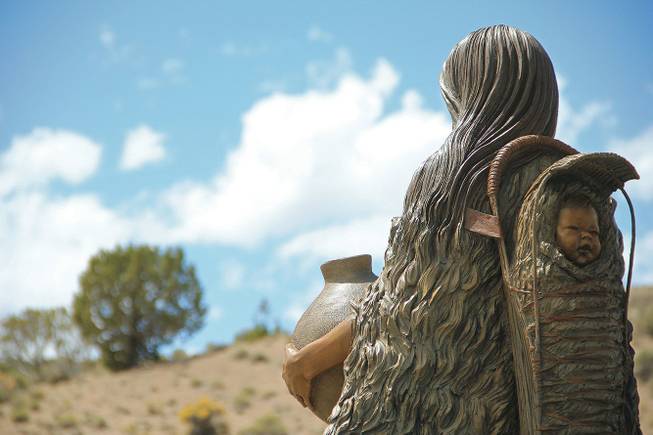
John Rasche/Elko Daily Free Press / Courtesy
The sculpture of a Great Basin Native American woman titled “Our Heritage is Our Future” stands in front of the California Trail Interpretive Center. This photo was taken a few days before the official unveiling.
Tuesday, July 2, 2013 | 2 a.m.
The night before the unveiling of a new sculpture at the California Trail Interpretive Center, Trevor Sneed sought guidance in the Ruby Mountains.
Sneed was asked to perform a song for the unveiling on behalf of the Te-Moak Tribe of Western Shoshone.
“The songs we mostly perform are round dances,” Sneed said. “And those didn’t seem appropriate for the situation.”
As a Shoshone custom, Sneed sought advice from his grandfather.
“My grandfather said, ‘No matter what pain it brings, remind them that we were here first and that we will continue to be here.’ So I went up the mountain, lit a fire and prayed. I told myself I wasn’t going to leave until I had the song.”
Six hours later, Sneed found his inspiration.
“I was sitting against the mountain ... and went back in time,” he said. “Alone in the mountains it’s how it would have been back then (before Westward expansion). ... And then the song came to me in the wind. The words finally came to me.”
Before the tarp was removed from the sculpture last Saturday, Sneed sang the song he had struggled so hard to find; the song was aptly titled “Dumbee Yapue,” Shoshone for “Rock Woman.”
The new sculpture, entitled “Our Heritage is Our Future,” displays a Great Basin native woman holding a woven basket and carrying an infant in a cradleboard on her back.
The unveiling at the visitor’s center along Interstate 80 was not merely to celebrate the sculpture’s aesthetic value, but also to embrace the union of government and tribal representatives behind its existence.
The artwork was selected by a committee of local Native American artists, historians and Gary Koy, the Bureau of Land Management’s Trail Center manager.
“I can’t thank them enough for bringing her here,” committee consultant Lois Whitney said regarding BLM’s involvement in the process. “I’m so glad they worked with the Shoshone people.”
Whitney acknowledged there was a stigma regarding government entities among some Native Americans but said she believed the sculpture was a symbol of good will.
“Some (Shoshone) still carry that hurt of how their people were treated ... but the BLM has made them feel welcome and asked for them to participate (in the sculpture’s process). Hopefully, this will be a process of healing because we all have to get along,” she said.
She said she hopes the new sculpture will encourage more of the Shoshone population to become involved in activities at the trail center.
The $20 million federal facility that formally opened last summer chronicles the story of the covered-wagon pioneers’ overland journey during the California Gold Rush.
Exhibits have been expanded this year to devote more attention to the American Indians of the Great Basin. In April, the BLM unveiled 1,000 square feet of new, colorful, acrylic murals inside the visitor center depicting people of the Shoshone, Paiute and Ute tribes from the early 1800s to modern times.
The facility near Elko, about 280 miles west of Reno, is the BLM’s third trail center but the first federal facility devoted exclusively to the California Trail. The agency operates similar centers in Casper, Wyo., and Baker City, Ore., along the Oregon Trail.
Norman Cavanaugh, the committee’s facilitator, praised BLM at last week’s ceremony for allowing the Shoshone people to play a part in the center’s development in northeast Nevada.
“We were given free rein as to what was appropriate for the sculpture,” Cavanaugh said. “I’m very proud of the people who were involved with this.”
As the tarp was removed from the sculpture, the spectators quietly gasped in awe and cheered.
Koy, who had helped remove the tarp, turned to the sculptor’s creator, Benjamin Victor.
“How long did you say this would last?” Koy asked.
“A sculpture like this lasts thousands and thousands of years,” Victor replied, smiling as the cheering and clapping grew louder.


Join the Discussion:
Check this out for a full explanation of our conversion to the LiveFyre commenting system and instructions on how to sign up for an account.
Full comments policy